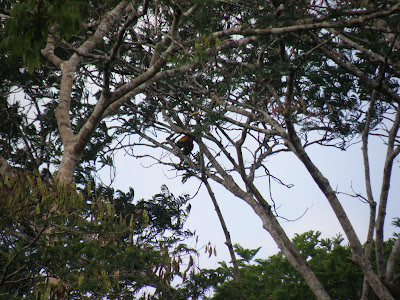The final trip began early on 15-May. After picking up Eddie Tzib from Cristo Ray village and Roni Martinez from San Antonio village, we made our way to Blancaneaux Lodge to pick up gear and on down the rough and tumble road to Kinlock Camp. It's no small miracle that we avoid getting stuck each time we take that route. The tires on the Isuzu Trooper were never made for the terrain.
Arriving at 10am, we were on the river by 11am and making our way up to the nest Erin and I discovered the previous week.

After cutting our way to the nest Marcial quickly scaled the tree and accessed the nest cavity. To our delight, there were 2 nestlings of approximately 40 days of age. The parents arrived back at the nest about 40 minutes later.
 The waiting game began...
The waiting game began... We heard the pair all afternoon but had no luck catching the female. Before dusk, Eddie and I made our way back to camp on the other side of the river. Marcial made his way back to camp and informed us that the female entered the cavity.

The next morning we arose at 4am and arrived at the nest around 4:30am. Unfortunately, the line to close the trap had slack in it and did not close in time to catch her. After breakfast, we headed back to the nest to wait for her return. At around 11:30am, as I was sitting under the nest tree daydreaming I heard a 'snap' to my left. Turning my head, a jaguar was standing less than 5 meters from me! It turned its head and we locked eyes. After a long three seconds, it turned its head and vanished into the forest understory. Let's just say that I was frozen and had a serious adrenaline rush!
At the end of the day we went back to camp and chilled out for the evening. Lots of catfish were swimming around after dark.

By 8:40am we released the female and she flew up into a small tree. She then climbed up and within 3 minutes she flew off.
We paddled down to Kinlock camp, ate lunch, and relaxed. We spent the afternoon searching the other side of the river, eventually splitting up. Eddie and I walked the old logging road to Blossom Berry Creek. While we both found macaw pairs, a nest was not located.

The following morning we paddled back upstream in the morning. About 1km upstream, we encountered a pair flying out from a clump of Quamwood. After cutting our way to the nest, Marcial climbed up the suspected tree. All that was found was an empty nest. He stayed up there waiting for the pair to return to the area. After a couple of hours they returned...to a cavity about 150 meters away. We made our way over to the tree. Marcial quickly climbed the tree and found a 30 day old chick.


After setting up the trap, we waited until dark.

As darkness came upon us we returned to camp. The female entered the nest after dark. The following morning we were up early and succeeded in catching her as Marcial climbed the tree.

This macaw seemed quite large. We quickly placed the collar and leg band on her and released her. She climbed up a stalk of dumb cane before flying over to a small tree. There she stayed for 5 to 10 minutes before flying off.

























